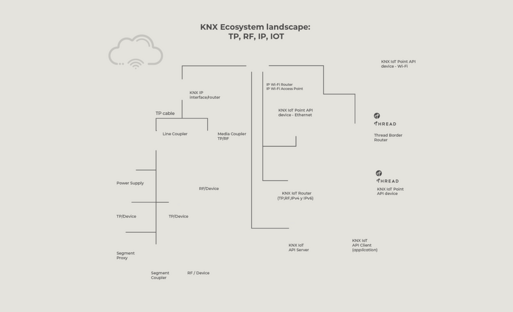
Los dispositivos y soluciones IoT KNX llevan las viviendas y edificios inteligentes al siguiente nivel.
¿Por qué KNX IoT?
- Interoperable y seguro: KNX ha sido la referencia cuando se habla de interoperabilidad. Basta con coger dos dispositivos certificados de cualquier proveedor, y simplemente trabajarán juntos a nivel de aplicación de forma segura. Siguiendo esta filosofía, KNX IoT ha sido diseñado para mantener el más alto nivel de seguridad. Los dispositivos KNX IoT vienen con seguridad integrada por diseño. Con esta nueva y robusta tecnología KNX IoT, los fabricantes y desarrolladores pueden construir los mejores dispositivos, soluciones y servicios que serán instalados por los profesionales de la industria de casas y edificios inteligentes.
- Dispositivos KNX IoT Nativos (IPv6): Los dispositivos KNX utilizan ahora un nuevo enfoque para adaptarse a la arquitectura IPv6. La nueva generación de dispositivos KNX IoT será capaz de conectarse a redes IP (cableadas y/o inalámbricas) para tener comunicación con otros dispositivos KNX IoT así como con dispositivos KNX clásicos que usen Twister Pair o Radio Frecuencia.
- API Estandarizada: Para Aquellos dispositivos que necesiten integrarse en una red KNX, ahora es posible gracias a una API estandarizada que puede conectar con instalaciones KNX. Esta API es simple, segura, abstraída del conocimiento específico KNX y a prueba de futuro.
- Una Herramienta: ETS: Todas estas capacidades son posibles gracias al uso de ETS. Con ETS, los dispositivos KNX de más de 500 fabricantes pueden ser configurados independientemente de su capa física, y la información del proyecto puede ser exportada a cualquier KNX IoT API Server utilizando una herramienta independiente del proveedor. ETS proporciona interoperabilidad básica en una herramienta atractiva con una interfaz de usuario moderna.
- KNX, el mayor ecosistema en automatización de viviendas y edificios: Con esta nueva posibilidad de comunicarse utilizando la Tecnología KNX, aporta más flexibilidad. Los fabricantes pueden ahora utilizar las nuevas posibilidades de desarrollo para crear productos y soluciones innovadoras; así como los profesionales tienen más posibilidades de crear un mayor ecosistema KNX en sus proyectos.
Convierta cualquier hogar y edificio en inteligente con KNX IoT
Descubra por qué KNX IoT abre un mundo de posibilidades para casas y edificios inteligentes en este breve vídeo de introducción.
Puede encontrar más vídeos detallados y webinars sobre KNX IoT en nuestro canal de YouTube.
KNX, el mayor entorno de desarrollo de su clase
En 2023 se ha presentado al mundo una innovadora plataforma de desarrollo que sirve de base para soluciones notables y que permite todos los casos de negocio en los verticales del hogar y la construcción inteligentes. Desde productos individuales a servicios, cualquier fabricante o desarrollador puede encontrar los recursos necesarios para crear soluciones únicas.
Descubra cómo funciona el Ecosistema KNX pasando el ratón por encima de los diferentes elementos en la siguiente imagen.
Desarrollo IoT KNX e Incubadora de Startups KNX
¿Está interesado en el desarrollo KNX IoT? Descubra más sobre KNX IoT y cómo puede desarrollar para KNX IoT, los beneficios y el apoyo que KNX ofrece a través de nuestra KNX Startup Incubator.
Acompáñenos en nuestro viaje
Crea una cuenta MyKNX para estar al día de lo último en KNX IoT, eventos tecnológicos, productos KNX innovadores y mucho más. Únase a nuestra comunidad para acceder a información exclusiva y formar parte del futuro de la energía sostenible. ¡Regístrese hoy y manténgase conectado!




















